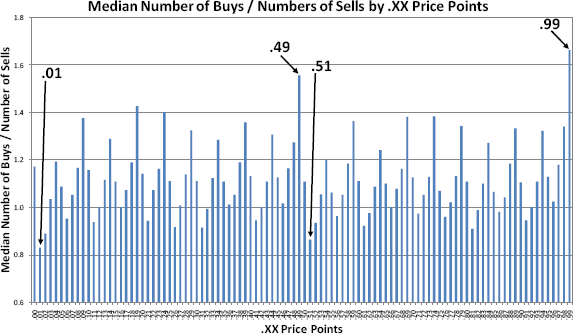Are the marketers right in believing that $1.99 attracts many more buyers than $2.00? In other words, do buyers irrationally fixate on the left-most digit of a price? If so, is there a way to exploit any associated stock trading tendencies? In their November 2008 paper entitled “Penny Wise, Dollar Foolish: The Left-Digit Effect in Security Trading”, Utpal Bhattacharya, Craig Holden and Stacey Jacobsen investigate the extent to which traders anchor on the left digit in stock prices. Using 100 million randomly selected stock trades during normal trading hours that are either above (buys) or below (sells) the bid-ask midpoint during 2001-2006, they conclude that:
- The maximum ratio of buys to sells (sells to buys) occurs for stock prices ending in .99 (.01).
- This effect exists is stronger when prices cross an integer from above or below.
- Technical (value-based) trading strategies triggered by crossing integers do not (may partially) explain findings.
The following chart, taken from the paper, shows the median ratio for the number of buys to number of sells for “cents” places ranging from .01 to .99. The chart suggests a “pennies effect,” “50-cent effect” and a “dollar effect.” The buy/sell ratio tends to be at a relative maximum (minimum) when the right-most digit is 9 (1). The highest ratio of buys to sells (1.67) occurs at trade prices ending in .99, and the lowest ratio of buys to sells (0.83) occurs at trade prices ending in .01. The second-place high and low occur for trade prices ending in .49 and .51, respectively.

In summary, relative demand for a stock peaks at $xx.99, while relative supply peaks at $xx.01, suggesting resistance to crossing dollar thresholds.
Perhaps these tendencies have some implications for setting limit and stop orders.